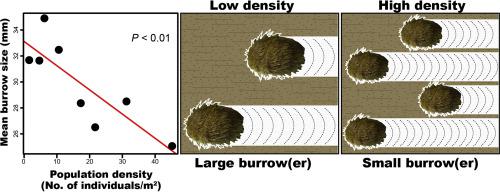当前位置:
X-MOL 学术
›
Palaeogeogr. Palaeoclimatol. Palaeoecol.
›
论文详情
Our official English website, www.x-mol.net, welcomes your feedback! (Note: you will need to create a separate account there.)
Does trace fossil size correspond with burrower population density? An example from the modern counterpart of the trace fossil Bichordites
Palaeogeography, Palaeoclimatology, Palaeoecology ( IF 3 ) Pub Date : 2020-11-01 , DOI: 10.1016/j.palaeo.2020.109946 Koji Seike , Kotaro Shirai , Kaoru Kubota , Yuki Ota , Shinji Sassa
Palaeogeography, Palaeoclimatology, Palaeoecology ( IF 3 ) Pub Date : 2020-11-01 , DOI: 10.1016/j.palaeo.2020.109946 Koji Seike , Kotaro Shirai , Kaoru Kubota , Yuki Ota , Shinji Sassa

|
Abstract The trace fossil Bichordites appears as an intrastratal burrow and occurs in shallow-marine deposits. Its modern counterpart is the burrow produced by the spatangoid echinoid Echinocardium cordatum, found in shallow-marine regions. The relationship between burrow size and tracemaker population density was studied in the modern, subtidal, sandy deposits of a ria coast in the northeastern Japan. Burrow size decreases with increasing population density in the modern counterpart, suggesting that trace fossil size in Bichordites can be used as a proxy to quantify tracemaker population density at the time of trace formation. However, the factors that control burrow size are unclear and warrant further investigation.
中文翻译:

追踪化石大小是否与穴居人口密度相符?来自痕迹化石 Bichordites 的现代对应物的一个例子
摘要 Bichordites 遗迹化石为地层内洞穴,产于浅海沉积物中。它的现代对应物是由在浅海地区发现的 spatangoid echinoid Echinocardium cordatum 产生的洞穴。在日本东北部 ria 海岸的现代潮下带沙质沉积物中研究了洞穴大小与示踪者人口密度之间的关系。洞穴大小随着现代对应物中种群密度的增加而减小,这表明双角线虫中的痕量化石大小可用作量化痕量形成时的示踪剂种群密度的代理。然而,控制洞穴大小的因素尚不清楚,需要进一步调查。
更新日期:2020-11-01
中文翻译:

追踪化石大小是否与穴居人口密度相符?来自痕迹化石 Bichordites 的现代对应物的一个例子
摘要 Bichordites 遗迹化石为地层内洞穴,产于浅海沉积物中。它的现代对应物是由在浅海地区发现的 spatangoid echinoid Echinocardium cordatum 产生的洞穴。在日本东北部 ria 海岸的现代潮下带沙质沉积物中研究了洞穴大小与示踪者人口密度之间的关系。洞穴大小随着现代对应物中种群密度的增加而减小,这表明双角线虫中的痕量化石大小可用作量化痕量形成时的示踪剂种群密度的代理。然而,控制洞穴大小的因素尚不清楚,需要进一步调查。


























 京公网安备 11010802027423号
京公网安备 11010802027423号